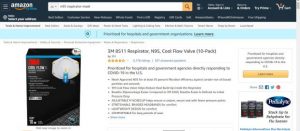Thanks to the COVID-19 outbreak, toilet paper has been flying
off the shelves. Will we run out of paper products? It’s a
question we wanted to get to the bottom of.
Toilet paper is one of those everyday items you take for granted
until it’s gone. The lack of toilet paper at the store is not
just happening in the U.S., but all over the world. Last week a new
website created in England titled howmuchtoiletpaper.com will
calculate how long a dwindling amount of TP will last.
The site has had more than 5 million visitors checking to see
how long their rolls will last based on how many visits to the
bathroom. The average user of the site has 500% more toilet paper
than they need for a 53-day quarantine.
Different world
One disclaimer the TP calculator makes is that not all countries
use the same type of paper. The average roll in the UK is said to
have 160 sheets, while some rolls in the U.S. might have 1,000
sheets depending on how much ply per sheet.
A 2006 study cited by the Massachusetts Institute of Technology
says the average roll of TP in the home’s most used bathroom
should last about five days.
That’s if the paper is used 6.6 times a day and consumers use
about 8.6 sheets on average.
That amounts to 42 rolls of two-ply or 21 rolls of one-ply in a
year.

Tissue issues
According to a report in Forbes last month, the U.S. supplies of
the vital paper are safe. In the case of paper goods, including
toilet paper, paper towels, napkins, tissues and diapers, about
two-thirds of that is made in the U.S. and only about 5% imported
from China.
Cincinnati-based Proctor & Gamble, which makes Charmin brand
toilet paper, states that 100% of its paper products are
manufactured in the U.S., and the materials are sourced mainly from
North America and Latin America.
The chart, below, from a 2013 report by Fastmarkets RISI, a pulp
and paper industry market analysis provider. It shows nations
tissue consumption per capita. Tissue consumption includes other
products such as paper towels and napkins.

No paper, no problem
It is estimated that about four billion people, or 70-75% of the
world’s population, does not use rolled toilet paper.
Rolling it out
The chart below is from Consumer Reports 2015 toilet roll
comparison. Brands can vary greatly in sheets and square feet per
role. Sample brands listed are just for size comparison purposes
only and not based on quality.

Flush factor
Prior to enactment of the Energy Policy Act of 1992, toilets
used from 3.5 to 5 gallons per flush. In 1992 a 1.6
gallon-per-flush standard was established but revised in 2010 to
let states to set their own standards.
This waiver of federal preemption allows states to set standards
provided they are more stringent than the national standard.

Toilets are one of the primary users of water in the home,
accounting for 26% of an average home’s indoor water usage,
according to a 2016 Water Research Foundation study.
TP highlights
The first toilet paper sold in the U.S. was in the 1850s and was
single sheets. It did not sell successfully.
The first rolls of toilet paper were patented in 1871 and E.
Irvin and Clarence Scott’s paper company began selling it
commercially 1879.
Initially the Scott’s did not want to the family name
associated with such practices, but by 1903 their success was so
great the Scott Tissue brand was well regarded.
Great Scott
Arthur Scott, E. Irvin’s son was the author of the Scott Paper
Company’s first effective slogan, “Soft as old linen.”
The Scott Paper Co. began rolling in profits because their
product coincided with the increase of indoor plumbing.
Walter T. Hughes, a doctor in the infectious diseases department
at St. Jude Children’s Research Hospital, stated that toilet
paper can be seen as more of a preventative health measure, much
like hand washing.

Sources: Massachusetts Institute of Technology, ReddiRooter,
Environmental Protection Agency, Consumer Reports,
Forbeshowmuchtoiletpaper.com, Proctor and Gamble
Related Articles
Coronavirus: Lake Tahoe officials take unprecedented step, tell Bay
Area visitors to keep out
California man arrested for alleged price gouging during
coronavirus fears, selling box of N95 masks for $300- Coronavirus:
New UCSF lab to boost Bay Area testing capacity
Coronavirus: Newsom says state will buy 200 million masks a
month
No paid sick leave, no problem: San Jose passes emergency policy
during coronavirus



















